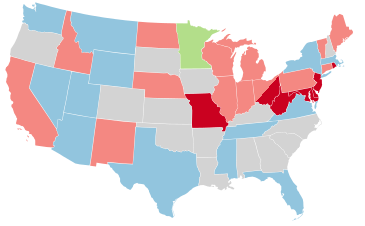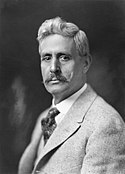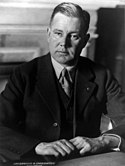1928 United States Senate elections
From Wikipedia, the free encyclopedia

Results of the elections: |
|
|
|
The 1928 United States Senate elections were elections that coincided with the presidential election of Republican Herbert Hoover. The 32 seats of Class 1 were contested in regular elections, and special elections were held to fill vacancies. The strong economy helped the Republicans to gain seven seats from the Democrats.
Senate Majority leader, Republican Charles Curtis of Kansas, was not up for election this cycle, but he was elected U.S. Vice President. He resigned March 3, 1929, so his seat was vacant at the beginning of the next Congress (March 4, 1929) until April 1, 1929, when a Republican was appointed to continue the term.
Gains, losses, and holds[edit]
Retirements[edit]
Two Republicans and one Democrat retired instead of seeking re-election.
Defeats[edit]
Seven Democrats sought re-election but lost in the primary or general election.
Disqualification[edit]
One Republican was elected in 1926, but disqualified from taking office. He resigned on February 9, 1928, and the seat was filled in the 1928 election.
Change in composition[edit]
Before the elections[edit]
At the beginning of 1928.
Elections result[edit]
Race summary[edit]
Special elections during the 70th Congress[edit]
In these special elections, the winner were seated during 1928; ordered by election date.
| State | Incumbent | Results | Candidates | ||
|---|---|---|---|---|---|
| Senator | Party | Electoral history | |||
| Idaho (Class 3) |
John W. Thomas | Republican | 1928 (Appointed) | Frank Gooding (R) died June 24, 1928, and Thomas was appointed June 30, 1928, to continue the term. Interim appointee elected November 6, 1928. |
|
| Illinois (Class 3) |
Vacant | 1926 Senator-elect Frank L. Smith (R) had been disqualified and resigned February 9, 1928.[2] New senator elected November 6, 1928. Republican gain. |
|||
| Michigan (Class 1) |
Arthur H. Vandenberg | Republican | 1928 (Appointed) | Woodbridge N. Ferris (D) died March 23, 1928, and Vandenberg was appointed to continue the term. Interim appointee elected November 6, 1928. Winner was also elected to the next term, see below. |
|
| New Mexico (Class 1) |
Bronson M. Cutting | Republican | 1927 (Appointed) | Interim appointee did not run to finish the term, but was elected to the next term, see below. New senator elected November 6, 1928. Republican hold. |
|
| Ohio (Class 3) |
Cyrus Locher | Democratic | 1928 (Appointed) | Frank B. Willis (R) died March 30, 1928, and Locher was appointed to continue the term. Interim appointee lost nomination. New senator elected November 6, 1928. Republican gain. |
|
Elections leading to the 71st Congress[edit]
In these general elections, the winners were elected for the term beginning March 4, 1929; ordered by state.
All of the elections involved the Class 1 seats, unless otherwise indicated.
Closest races[edit]
Twelve races had a margin of victory under 10%:
New Mexico was the tipping point state with a margin of 15.4%.
Arizona[edit]
California[edit]
Connecticut[edit]
Delaware[edit]
Florida[edit]
Idaho (special)[edit]
Illinois (special)[edit]
Indiana[edit]
Maryland[edit]
Massachusetts[edit]
Michigan[edit]
First-term Democrat Woodbridge N. Ferris died March 23, 1928.
On March 31, 1928, Governor Fred W. Green appointed 44-year-old Republican Arthur H. Vandenberg to fill the vacancy, pending a special election. Green considered resigning so he could be appointed to the vacancy. He also considered several other candidates, including former governors Albert Sleeper and Chase Osborn. In addition, Green considered Representative Joseph W. Fordney, who would have been a placeholder until the election for the remainder of Ferris’ term. Green finally decided upon Vandenberg, who immediately declared his intention to stand for election to both the short, unexpired term and the full six-year term. Both the special and the general elections were held the same day, November 6, 1928.
Michigan (regular)[edit]
Michigan (special)[edit]
Minnesota[edit]
Mississippi[edit]
Missouri[edit]
Montana[edit]
Nebraska[edit]
New Jersey[edit]
New Mexico[edit]
Two-term Democrat Andrieus A. Jones died December 20, 1927. Republican Bronson M. Cutting was appointed December 29, 1927, to continue the term, pending a special election in which he was not a candidate.
New Mexico (special)[edit]

Larrazolo was not a candidate, however, for the next term. After leaving office, Larrazolo died on April 7, 1930.
New Mexico (regular)[edit]

Cutting would be re-elected in 1934 but died May 6, 1935.
New York[edit]
North Dakota[edit]
There were 2 elections due to the March 30, 1928, death of Republican Frank B. Willis.
Ohio (regular)[edit]
Ohio (special)[edit]
Democrat Cyrus Locher was appointed April 5, 1928, to continue the term, pending the special election, in which he lost his party’s nomination.
Burton, in turn, died October 28, 1929, triggering another interim appointment and special election before the 1933 end of the term.
Pennsylvania[edit]
Rhode Island[edit]
Tennessee[edit]
Vermont[edit]
Virginia[edit]
Washington[edit]
West Virginia[edit]
Wisconsin[edit]
Wyoming[edit]
See also[edit]
- ^ a b c Appointee elected
References[edit]
- ^ September 10, 1928, in Maine
- ^ “SMITH, Frank Leslie – Biographical Information”. Bioguide.congress.gov. Retrieved December 27, 2013.
- ^ “Our Campaigns – Container Detail Page”. www.ourcampaigns.com.
- ^ “Our Campaigns – NM US Senate – Special Election Race – Nov 08, 1928”. www.ourcampaigns.com. Retrieved April 10, 2021.
- ^ “Our Campaigns – AZ US Senate Race – Nov 06, 1928”. www.ourcampaigns.com.
- ^ a b c d e f g h i j k l m n o p q r s t u v w x y z aa ab ac ad ae af ag ah “Statistics of the Congressional Election of November 6, 1928” (PDF). Clerk of the United States House of Representatives. Retrieved July 4, 2014.
- ^ Office of the Secretary of Commonwealth of Massachusetts (1928). Number of assessed polls, registered voters and persons who voted in each voting precinct in the Commonwealth of Massachusetts at the state, city and town elections. p. 375.
- ^ “General Election Results – U.S. Senator – 1914-2014” (PDF). Office of the Vermont Secretary of State. Archived from the original (PDF) on March 4, 2016. Retrieved June 16, 2015.
Recent Comments